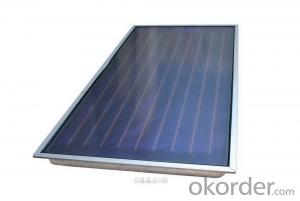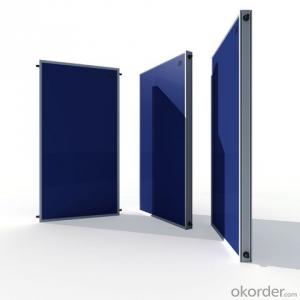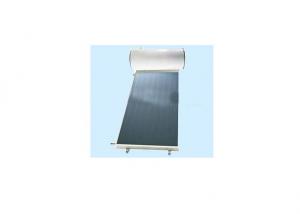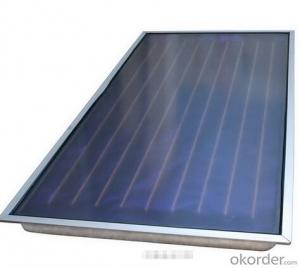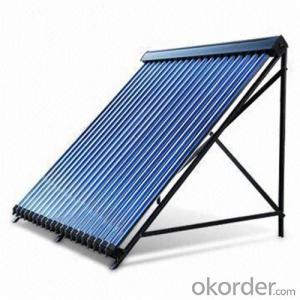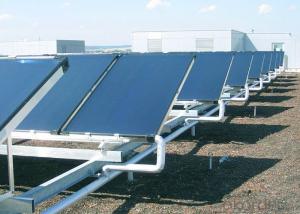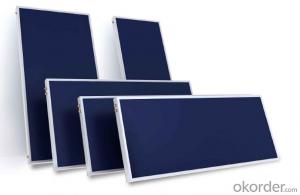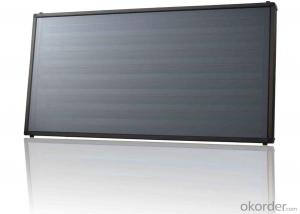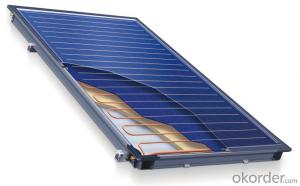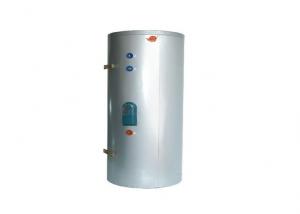Black chrome flat panel solar thermal collector
- Loading Port:
- Shanghai
- Payment Terms:
- TT OR LC
- Min Order Qty:
- 500 pc
- Supply Capability:
- 10000 pc/month
OKorder Service Pledge
OKorder Financial Service
You Might Also Like
Specifications
Flat panel solar thermal collector
Low iron tempered glass
Core: all Copper, ultrasonic welding.
Coating: black chrome
Flat panel solar thermal collector
consist of glazed, flat, dark surfaced absorber plate which contains copper tubing. The Plate absorbs incoming solar heat energy and the casing minimises heat loss. A fluid is circulated through the tubing and this fluid heats up as it passes by the absorber plate.
Feature:
1) Absorptance: ≥95%±2%.
2) Material:thickness:low iron rohbic tempered glass x thickness: 3.2mm.
3) Glass sheet size: 1988×988 mm.
4) Glass transmittance: 87%~91%.
6) Insulation material:Rock wool.
7) Back sheet material: Zincification plate0.3mm; embosseo Aluminum0.5mm.
8) Cross area: 2 m2.
9) Heat absorber area: 1.8 m2.
10) Fluid content: 2L.
11) Maximumpressure: 1 Mpa.
12) Operation temperature: -40~150°C.
Flat Plate Collectors
Flat plate collectors are the most common solar thermal collectors. They are most appropriate for low temperature applications, such as domestic hot water heating. Flat plate series water heaters maximizes solar heat gain, minimizes heat losses, and provides for the most efficient heat transfer from absorber plate to tube.
Flat Plate Solar Collectors are a glazed collectors which
feature a coating which maximizes heat absorption, aluminum framing which can withstand heavy weight and is weather resistant, and interior fiberglass insulation which allows for greater efficiency. The combination the latest energy efficiency technology and a strong heat exposure allow for optimal heat transfer and makes these lights the highest in BTU performance.
An important asset of flat plate solar collectors is their versatility. Their excellent efficiency makes them also suitable for the operation of larger systems for commercial or public use. Solar Flat Plate collectors are typically recommend for use in warmer climates simply because they are designed with larger absorber areas that are not insulated from the colder weather.
- Q:How do solar collectors contribute to reducing water consumption?
- Solar collectors contribute to reducing water consumption by providing an alternative and more sustainable method for heating water. Traditional water heating systems rely on fossil fuels or electricity, both of which require significant amounts of water for their extraction, processing, and generation. In contrast, solar collectors use the sun's energy to heat water, eliminating the need for water-intensive processes. Solar collectors work by absorbing sunlight and converting it into heat, which is then transferred to the water in the system. This process does not require any additional water, making it a water-efficient option for heating water. By utilizing solar collectors, water consumption is reduced because there is no need for water to be used in the generation of electricity or in the extraction and processing of fossil fuels. Additionally, solar collectors can also contribute to reducing water consumption by utilizing a closed-loop system. In this system, the water in the collector is circulated through pipes, heated by the sun, and then returned to a storage tank. This allows for the reuse of the same water, further reducing the need for fresh water. This closed-loop system also minimizes the risk of contamination, as the water is contained within the system and not exposed to external pollutants. Overall, solar collectors play a crucial role in reducing water consumption by providing an environmentally friendly and sustainable method for heating water. By relying on the sun's energy, they eliminate the need for water-intensive processes involved in traditional water heating systems, ultimately helping to conserve water resources.
- Q:Are there any noise concerns associated with solar collectors?
- Yes, there are typically no noise concerns associated with solar collectors. Unlike traditional energy sources such as generators or turbines, solar collectors do not have moving parts that generate noise.
- Q:Can solar collectors be used for generating electricity on airports?
- Yes, solar collectors can be used for generating electricity on airports. Solar panels can be installed on rooftops, parking lots, or unused land at airports to harness solar energy and generate electricity. This renewable energy source can help airports reduce their carbon footprint, decrease reliance on fossil fuels, and contribute to a greener and more sustainable operation. Additionally, solar power can provide a reliable and cost-effective energy solution for powering various airport facilities and operations.
- Q:Can solar collectors be used for heating bus stations?
- Yes, solar collectors can be used for heating bus stations. Solar collectors can harness the sun's energy to generate heat, which can then be used to warm up bus stations. This can be a sustainable and cost-effective way to provide heating in these public spaces.
- Q:Can solar collectors be used in any climate?
- Solar collectors can be used in any climate, as they are designed to capture and convert sunlight into usable energy. However, certain climates with more sunlight and less cloud cover generally provide more efficient results.
- Q:What is the typical warranty period for solar collectors?
- The typical warranty period for solar collectors can vary, but it is commonly around 10 to 25 years.
- Q:Can solar collectors be used for heating car rental facilities and parking lots?
- Yes, solar collectors can be used for heating car rental facilities and parking lots. Solar thermal systems can be installed to capture and convert sunlight into heat energy, which can then be used to provide heating for buildings and open spaces such as parking lots. This can help reduce energy costs and reliance on fossil fuels, making it an environmentally friendly and sustainable solution for heating car rental facilities and parking lots.
- Q:Can solar collectors be used in combination with radiant floor heating systems?
- Yes, solar collectors can be used in combination with radiant floor heating systems. In fact, this combination is quite effective in providing sustainable and efficient heating solutions for buildings. Solar collectors, such as solar thermal panels or evacuated tube collectors, use the sun's energy to heat a fluid, usually water or a mixture of water and antifreeze. This heated fluid is then circulated through a system of pipes embedded in the floors, providing radiant heat to the space. The advantage of using solar collectors in combination with radiant floor heating is that it allows for renewable and clean energy to be used for space heating. By harnessing the power of the sun, the reliance on fossil fuels or electricity is reduced, resulting in lower energy costs and carbon emissions. Additionally, solar collectors can provide a significant portion of the heating needs, especially during the sunny seasons, further reducing the reliance on traditional heating systems. However, it is important to note that the effectiveness of this combination depends on various factors such as the climate, solar resource availability, and system design. In regions with limited solar exposure, the solar collectors may not be able to provide sufficient heat for the radiant floor system, necessitating the use of a backup heating source. Therefore, a thorough assessment of the specific conditions and requirements of the building is necessary to determine the feasibility and optimal design of the solar collector and radiant floor heating system combination.
- Q:How much do solar collectors cost?
- Solar collector costs can vary depending on factors like system size, collector type, and installation requirements. On average, a solar collector system can range from $5,000 to $20,000, covering collectors, installation, and additional components like tanks or pumps. It's worth noting that although there is an initial cost, solar collectors can yield significant long-term energy bill savings and may qualify for government incentives or tax credits, further reducing overall expenditure. Moreover, advancements in technology and market competition have led to a decrease in solar collector costs over the years, making them more affordable and accessible to homeowners and businesses.
- Q:Are solar collectors suitable for agricultural greenhouses?
- Yes, solar collectors are suitable for agricultural greenhouses. They can effectively capture and convert solar energy into heat, which can be used for maintaining optimal temperature and providing supplemental heating in greenhouses. This helps in enhancing plant growth, extending the growing season, and improving overall crop yield. Additionally, solar collectors offer a sustainable and cost-effective solution for greenhouse operations by reducing reliance on traditional energy sources.
1. Manufacturer Overview |
|
|---|---|
| Location | |
| Year Established | |
| Annual Output Value | |
| Main Markets | |
| Company Certifications | |
2. Manufacturer Certificates |
|
|---|---|
| a) Certification Name | |
| Range | |
| Reference | |
| Validity Period | |
3. Manufacturer Capability |
|
|---|---|
| a)Trade Capacity | |
| Nearest Port | |
| Export Percentage | |
| No.of Employees in Trade Department | |
| Language Spoken: | |
| b)Factory Information | |
| Factory Size: | |
| No. of Production Lines | |
| Contract Manufacturing | |
| Product Price Range | |
Send your message to us
Black chrome flat panel solar thermal collector
- Loading Port:
- Shanghai
- Payment Terms:
- TT OR LC
- Min Order Qty:
- 500 pc
- Supply Capability:
- 10000 pc/month
OKorder Service Pledge
OKorder Financial Service
Similar products
New products
Hot products
Hot Searches
Related keywords
